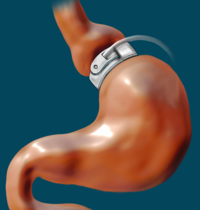
Photo from wikipedia
AIM To determine the feasibility, safety, and oncological outcome of laparoscopic resection of gastric gastrointestinal stromal tumors (GISTs) based on favorable or unfavorable location. METHODS Our hospital database included 207… Click to show full abstract
AIM To determine the feasibility, safety, and oncological outcome of laparoscopic resection of gastric gastrointestinal stromal tumors (GISTs) based on favorable or unfavorable location. METHODS Our hospital database included 207 patients who underwent laparoscopic removal of gastric GISTs from January 2004 to September 2015. Patient demographics, clinical presentation, surgery, histopathology, postoperative course, and oncological outcomes were reviewed and analyzed. RESULTS Gastric GIST in favorable locations was present in 81/207 (39.1%) cases, and in unfavorable locations in 126/207 (60.9%) cases. Overall mean tumor size was 3.28 ± 1.82 cm. No conversions occurred, and complete R0 resection was achieved in 207 (100%) cases. There were three incidences of iatrogenic tumor rupture. The feasibility and safety of laparoscopic surgery were comparable in both groups with no statistical difference between unfavorable and favorable location groups, respectively: for operative time: 83.86 ± 44.41 vs 80.77 ± 36.46 min, P = 0.627; conversion rate: 0% vs 0%; estimated blood loss: 27.74 ± 45.2 vs 29.59 ± 41.18 mL, P = 0.780; tumor rupture during surgery: 0.90% vs 2.82%, P = 0.322; or postoperative complications: 3.74% vs 7.04%, P = 0.325. The follow-up period recurrence rate was 1.89% with no significant differences between the two groups (3.03% vs 0%, P = 0.447). Overall 5-year survival rate was 98.76% and survival rates were similar between the two groups: 98.99% vs 98.39%, P = 0.623 (unfavorable vs favorable, respectively). CONCLUSION The laparoscopic approach for gastric GISTs is safe and feasible with well-accepted oncological surgical outcomes. Strategies for laparoscopic resection should be selected according to the location and size of the tumor. Laparoscopic treatment of gastric GISTs in unfavorable locations should not be restricted in gastrointestinal centers.
Journal Title: World Journal of Gastroenterology
Year Published: 2017
Link to full text (if available)
Share on Social Media: Sign Up to like & get
recommendations!